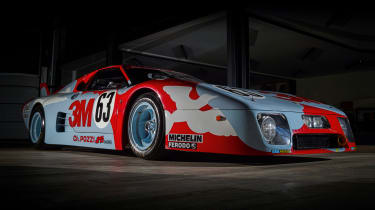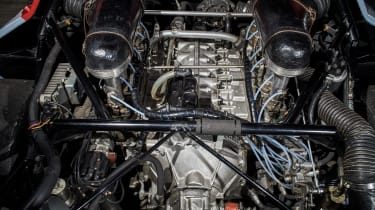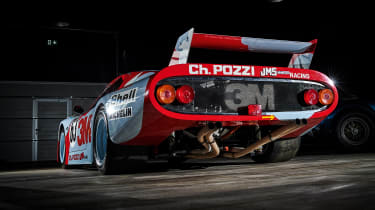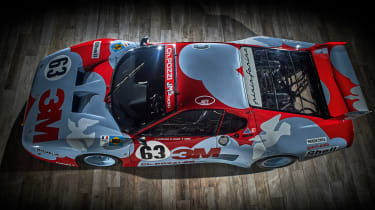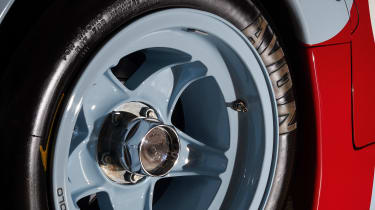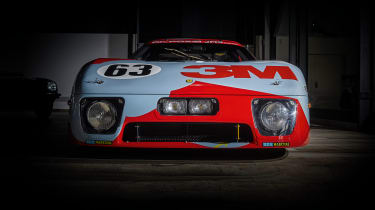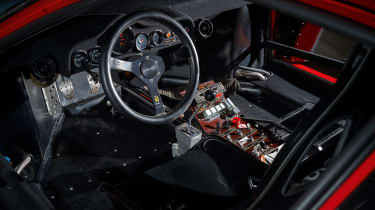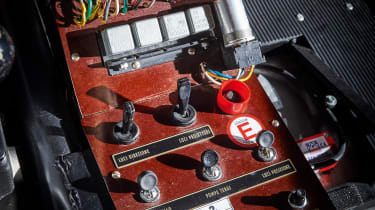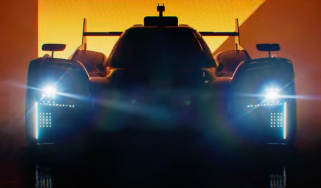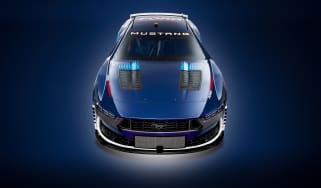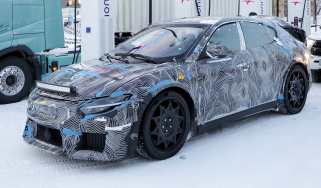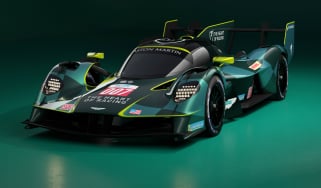Ferrari 512B B/LM: the anatomy of a V12 Le Mans racer
The Berlinetta Boxer was Ferrari’s first mid-engined road car and it spawned one of the most spectacular endurance racers of the late-’70s. We look under its skin
It took a little while for the men from Maranello to get their first mid-engined supercar into production; time-served Il Commendatore folklore has it that Enzo preferred his prancing horses pulling the cart, not pushing them. Nevertheless, the dazzling appeal, drama and commercial threat of the Lamborghini Miura could not be ignored, and in 1973, seven years after the emergence of the mid-engined Lambo, Ferrari launched its new road car flagship, the 365 GT4 BB.
The ‘Berlinetta Boxer’ had been first seen at the Turin motor show of 1971 and took plenty of inspiration from Pininfarina’s P6 concept of 1968. An elegant, dart-like form, what it lacked of the pioneering bravado possessed by both the Miura and its Countach successor it made up for with a timeless beauty that hasn’t faded with the passing decades.
> Mazda 787B: the anatomy of a rotary Le Mans icon
The flat 12-cylinder engine really did have a direct link to Ferrari’s competition machines of the 1960s and ’70s, though in fact the name ‘Boxer’ is a misnomer. The engine is actually a 180-degree V12, not technically a ‘boxer’ engine at all, as opposing pistons use the same crankpin and hence move together in the same direction and not independently punching towards each other as in, say, a Porsche flat-six.
In spite of its fashionable layout, the BB was otherwise largely conventional and ‘classic Ferrari’. It featured a spaceframe chassis of oval and rectangular tubing, over which sheet steel was welded in to create a central ‘tub-like’ structure. On top of this was placed an inner glassfibre skin, with the metal body panels over the top of that.
The ‘F102A’ flat-12 was in many ways a flattened Daytona V12, with the same bore and stroke giving the same individual cylinder capacity of 365cc – hence the name – and overall capacity of 4390cc. It inhaled through four Weber 40 IF 3C triple-choke carburettors and exhaled through an extravagant exhaust system with no fewer than six tailpipes, three exiting either side below the rear bumper. Power was initially claimed to be around 380bhp, but even Ferrari downgraded that figure once the car was in production, and somewhere around 340bhp was probably more realistic.
Suspension was by the usual Ferrari unequal-length wishbones front and rear, with coil springs, telescopic dampers and anti-roll bars, the only novelty being twin dampers at the rear to cope with the weight of the engine. Disc brakes featured on both axles; rack and pinion steering was used, and there was a five-speed manual gearbox with the traditional open-gate Ferrari shifter.
What marked the BB out as unique, and defined its dynamics in many ways, was Ferrari’s decision on packaging. Answering the challenge of retaining decent luggage space while finding a home for a very large 12-cylinder engine in a small car, the engineers decided upon a novel arrangement whereby the gearbox was placed below and to the side of the engine, with drive taken via the flywheel through three helical step-down gears and to a long quill shaft that ran back beneath the crankshaft. The fact that the cylinders were flat and not in a vee helped to offset the obvious downsides of raising the engine to make this possible.
For 1978, Ferrari upgraded the original 365 to the 512, changing the naming convention in the process so that the ‘5’ now stood for the total litres of displacement and ‘12’ the number of cylinders. To achieve 4942cc both bore and stroke were increased, and this, plus alterations to timing and the compression ratio, added up to a more tractable engine in line with the increasingly less-hardcore aspirations of Ferrari’s emerging new clientele. Although more torquey, at 360bhp it was less powerful than Ferrari’s official figures for the old 4.4-litre engine, although once again all these figures are thought to be very optimistic.
It was this engine that formed the basis of the definitive 512 BB/LM of 1979 – the factory competition variant featured here – while a visual distinction with the 512 BB was the addition of small flares on the wheelarches to accommodate the 9-inch wide rear wheels with 225 Michelins (up from 215 on a very meagre 7.5-inch rim!). A front bib spoiler was also introduced, and the number of exhausts visible at the rear shrunk to ‘just’ four.
There was one more update to the Boxer to see it through its final years before being replaced by the Testarossa in 1984. The 512 BBi of 1981 featured, as the name implies, Bosch K Jetronic fuel injection to assist with emissions control and was slightly less powerful again, by another 5bhp.
Racing history
While there was initially no interest from Ferrari in going racing with the BB, that didn’t stop independents finding the big supercar’s qualities too tempting to resist, starting with Luigi Chinetti’s NART operation, the official Ferrari importer for North America.
They built a radically modified competition car from a 365 GT4 BB and entered it in the 1975 edition of the 24 Hours of Daytona. Ignominiously, it retired on the very first lap, but proved its speed later in the year, while Ferrari agreed to supply a number of competition engine parts. NART then moved on to Le Mans, but while the Boxer qualified after one of the team’s other entries was moved to a different class by the organisers, Chinetti withdrew all his cars before the race in a huff. In fact, a Boxer didn’t race at Le Mans until 1977, when NART’s original car took the start and finished 16th overall and fifth in class.
By 1978 momentum was gathering for racing Boxers, with five showing up at Le Mans, including three new racing versions built by Ferrari, who seemed to be having a change of heart. This new car – sometimes confusingly referred to as a Series 1 512 BB/LM and much more conventional than the car you see in these photos – had first been seen at Fiorano at the beginning of the year and was a fairly serious attempt at creating a competitive BB sports racer.
NART brought its ’75 car, but also had one of Ferrari’s new competition versions, as did French importer Charles Pozzi, who brought along two of the new models. A final, independently built car from the Belgian Ferrari importer made up the five-pronged Ferrari attack.
There were mixed fortunes in the race, with the strongest finisher –ironically the old NART 365 model – coming home in 16th place and 4th in the IMSA GTX class.
Perhaps spurred on by the potential shown, or lobbied further by its importers, Ferrari set about creating the definitive BB/LM in late 1978, and an altogether different Boxer was first seen testing at Fiorano. Developed by engineers Giuseppe Girotti and Gaetano Florini in the Assistenza Clienti department of the racing operation, the 512 BB/LM would be Ferrari’s last internally developed endurance racer before the appearance of the 499P for 2023, and was pitched firmly at snatching Group 5 category glory from Porsche’s formidable 935. Nine of these 1979 models were built, with a further 16 the following year.
The BB/LM’s debut came at the 1979 Daytona 24 Hours, with two cars entered by Pozzi and one by NART. Alas, it was an inauspicious debut and perhaps a portent of things to come: the 512’s new Michelin Radials gave trouble, and after a blow-out on the banking it was decided to retire the whole fleet early in the race – despite all the cars running in the top ten at the time – rather than risk any further and potentially lethal mishaps.
The next stop was Le Mans, with four new BB/LMs entered, including the example here. In a race of mixed fortunes, three of the cars retired either through mechanical issues or accidents, leaving the Belgian entry to register a 12th place overall. Nevertheless, a BB/LM had run as high as fifth at one point, which suggested the speed was there.
Sadly, over the next few seasons the BB/LM never did wrest the laurels away from arch-rival Porsche in the Group 5/IMSA categories. Usually outnumbered, it was labouring under a significant power deficit too. At Le Mans in 1980 five were entered, with the best coming home 10th overall and third in class. One ran as high as second at Daytona the following year, but in other smaller races the type suffered with mechanical unreliability. Yet at Le Mans in 1981 a Boxer finally won its class and scored an excellent fifth overall – the best result recorded by a BB/LM.
The following year was effectively the LM’s swan-song in international competition as the rule set changed over to the Group C and B formulas for sportscar racing; from 1983 the car would be eligible only under the IMSA regulations. A commendable sixth and ninth were the best results at Le Mans in ’82, and that, bar fleeting further appearances and some club-level competition over the following decade, was that.
Engine and gearbox
The flat-12 was the absolute centrepiece of the Boxer road car, and it would be no different for the competition version. Whereas in 1978 Ferrari had quoted around 400bhp from the modified 5-litre engine in the Series 1 competition BB, which still ran on Weber carburettors, for the definitive (Series 2) BB/LM of 1979 Ferrari raised the output significantly, with around 470-480bhp delivered from the dry-sumped, 5-litre engine, thanks largely to the adoption of Lucas mechanical fuel injection instead of carbs, although the two-valves-per-cylinder configuration was retained. Maximum revs was stated as 7000rpm.
Both the gearbox internals and the clutch were strengthened to cope with the additional power and the need to last for up to 24 hours in endurance racing.
Chassis, body & aerodynamics
Ferrari’s first attempt at a competition 512 BB in 1978 was a rather odd-looking machine. The more powerful engine was fed by giant air intakes on top of the engine (still on carbs at this point), while a large and slightly ungainly rear wing was said to have been sourced from the 312 T3 Grand Prix car of that year – and looks as out of place as you might expect because of it. At the front, Ferrari offered a choice of two noses, with the longer, ‘low drag’ option featuring a strange oval intake like something from the 1960s, which was then festooned with a pair of large spot lamps, presumably negating any aero advantage. Lighter bodywork and other weight-saving measures reduced the mass by around 200kg, taking the average weight of the 512 entries at Le Mans in 1978 to just over 1200kg.
For the definitive 1979 model, the most obvious change was an entirely new body, which had been developed by Pininfarina at its wind tunnel in Grugliasco, Turin. Resembling a great whale, it clothes the short-wheelbase, compact Ferrari with a long, flowing form that significantly extends both the nose and the tail and smoothly flares in much wider wheelarches. The pop-up lights are replaced by fixed units, and the nose is now blunt and low to the road in a much more modern style, while the flying buttresses aft of the cockpit have been replaced by a faired-in, sloping rear screen that culminates in a much more convincing rear spoiler. Angry, matt-white exhaust pipes jut aft from an open rear, with the back of the flat-12 clearly visible behind a mesh panel. No longer do the sides elegantly taper inwards, instead featuring a more blocky shape.
The entire rear clamshell lifts up, revealing just how short the BB actually is beneath its new body. In fact, the 1979 BB/LM is 15.6 inches longer and 5.9 inches wider than a standard Boxer silhouette, at the cost of an additional 30kg. It was claimed the new car had topped 212mph at Nardo, but no BB/LM ever exceeded 200mph on the Mulsanne straight…
In 1980 the second series of visually almost identical cars featured deeper and flatter sills, a lighter spaceframe chassis and glassfibre for much of the exterior panels, reducing the weight by up to 100kg. The ducts in front of the rear wheels were also enlarged.
Suspension, tyres & brakes
Naturally, the BB/LM would have a race-prepared chassis, with rubber bushing replaced by uniball joints and racing springs and dampers. The geometry was altered for the racers, not least because the track both front and rear was much wider under the new Pininfarina bodywork. LMs were delivered on Gotti alloy wheels, 10in/13in front/rear, and shod with Michelin TR-X radial tyres in the metric sizes of 23/59x15 and 34/61x15, front and rear respectively. Both the brake discs and calipers were upgraded significantly with racing-spec items.
This car: chassis no. 26685
One of the first true BB/LMs built, 26685 debuted the new type at the 1979 Daytona 24 Hours. Its next race was Le Mans, where both Pozzi cars turned out with a striking ‘clouds’ livery designed by French artist Jean Feugerol, this car sponsored by the 3M company. With a strong driver line-up of Jean-Claude Andruet, Michel Leclère and Claude Ballot-Léna, this LM was unsurprisingly the fastest of the type in practice, qualifying 28th. It had risen as high as 10th when Leclère tangled terminally with a small prototype at the end of the Mulsanne. Its final race appearance came again at Le Mans the following year, where it was part of a three-car Pozzi team all decked out in a striking navy and yellow livery. Now the oldest (and heaviest) of the BB/LMs on the grid, it was having an unspectacular race when it retired early on.
Returned to Ferrari for repairs, it actually went to Pininfarina for updating to the 1980 body style. Its racing career now over, it was sold to a Polish prince and resided in a collection until eventually ending up with English Ferrari collector Nigel Chiltern-Hunt in the late 1990s; he carried out a full restoration and returned it to the ‘clouds’ livery you see today. It attended its first Historic race meeting in 2001 and was a regular at Ferrari club concours events until returning to France in 2010. It was acquired there in 2019 by a friend of Ballot-Léna who wanted a car driven by the French driver in-period.
Driving a 512 BB/LM
Sam Hancock is a professional racer and regular BB/LM pilot. ‘These cars have a huge amount of character,’ he tells us. ‘I’ll never forget during Le Mans Classic one year the run from Mulsanne Corner to Indianapolis, at high speed during the night, with the noise of that engine and thinking, “Sam, this is about as good as it gets.”
‘There are faster, nicer, better cars, but there’s something wonderful about being sat behind that steering wheel with the prancing horse on the boss, the tall gearlever with the open-gated shift, and the induction note of the engine.
‘It’s rare in Historic racing to have the chance to really set up a car and practise; it’s a luxury. But this unlocked a level of performance I never thought would be there. Initially it felt like it was a fun car, with a torquey, leggy engine that tolerates using higher gears and just pulls and pulls, but one that in medium and high-speed corners, well… when it starts to roll, you have that massive engine, a high C of G, a reasonably short wheelbase, and as soon as steering lock goes on that feeling sets in, disconcertingly more and more as the speeds rise. It’s not actually oversteering, but you can tell an “event” is coming but you don’t know what that is! It was hard to feel what was happening, but that all changed with the set-up improvements.
‘I changed things dramatically – tyres, springs, suspension settings – and got a completely different balance. It always did well in low-speed corners; the grip at the Monza chicane was shocking. But now the braking is far better, and I have to tell myself to brake later, as you can absolutely monster the pedal. It’s rock-solid stable at high speed, although you have to have the ride height just right. Now you can trail the brakes right into the apex, and that wasn’t possible before, so I can leave my braking much later and there’s none of the understeer you can get when racing Historics. I was shocked you can do that with the 512 BB/LM; it’s just fundamentally an extremely good car. You can break traction in slow corners, but it’s pretty neat and tidy overall.
‘All Ferrari gearboxes of that era are questionable, but it’s not bad. You have to be sensitive to it, guide it as opposed to forcing it. That does slow the shift down a bit, and it’s not the shortest throw, but it’s nice to use. Coming into a corner I’ll lose 50 per cent of the speed first with just the brakes and then go down each gear in turn with a massive heel-and-toe of revs. The engine picks up instantly and has very little inertia.
‘I have driven a Porsche 935 before – perhaps the ultimate Group 5 car – and that felt more like a GT car, whereas the BB/LM is a step or two towards the sports-prototype feeling.’
The market
‘It’s a Ferrari that’s raced at Le Mans, and in the Ferrari world to have a competition car that’s raced at Le Mans is special,’ says Max Girardo of Girardo and Co, who recently sold this car. ‘I think it’s more special when it’s not a road car but a proper racer, but the market doesn’t seem to agree because they’re undervalued at present. We had this one up for sale at 3 million euros. A Competition Daytona is more, a 275 GTB/4 road car about the same. And while Group 5 isn’t perhaps the coolest era of racing, you can now do Le Mans Classic with this car.’
This story first featured in evo issue 320.

